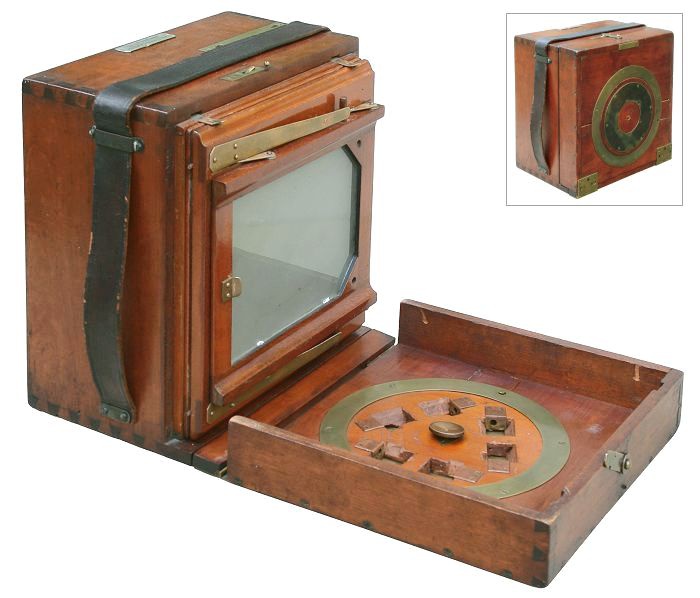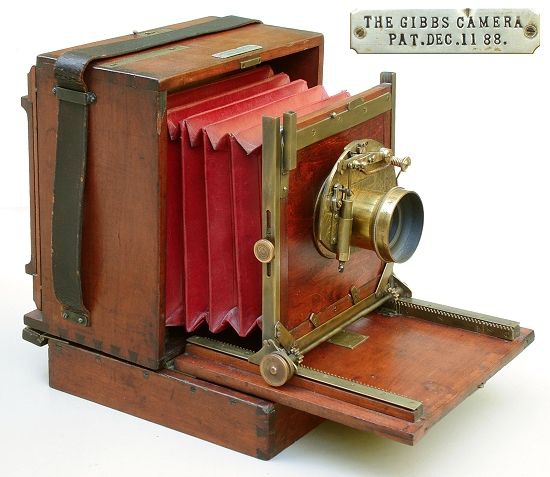|
|



Copyright ©2009 by Rob Niederman - ALL RIGHTS RESERVED
Visit the Gibbs Patent page
Return to the Self-Casing Cameras page
Return to the Self-Casing Cameras page
The first advertised self-contained camera. While generally
recognized that the development, maturity and immense
popularity of "self-casing" cameras (a collector term) was
primarily in the 1890s, their legacy starts in 1883 with G. Frank E.
Pearsall's patented Compact Camera. Yet its non-acceptance
gives an appearance that the innovative design was nothing more
than a novelty.
As the self-casing camera concept languished throughout the intervening years, a second attempt was tried in 1888 with little fanfare by an unknown American builder: William C. Gibbs of Oakland, California. It too failed to capture the hearts of photographers and only a couple surviving examples are known.
Given their lackluster reception, Pearsall's and Gibbs' self-casing cameras must have seemed like an exercise in futility. But the two attempts served as the embers from which the approach would be resurrected with George Eastman's No. 4 Folding Kodak Camera of 1890; a design that eventually ignited the body pattern's desirability.
As the self-casing camera concept languished throughout the intervening years, a second attempt was tried in 1888 with little fanfare by an unknown American builder: William C. Gibbs of Oakland, California. It too failed to capture the hearts of photographers and only a couple surviving examples are known.
Given their lackluster reception, Pearsall's and Gibbs' self-casing cameras must have seemed like an exercise in futility. But the two attempts served as the embers from which the approach would be resurrected with George Eastman's No. 4 Folding Kodak Camera of 1890; a design that eventually ignited the body pattern's desirability.
Multi-Lens Cameras | View Cameras | Self-Casing Cameras | Solid Body Cameras | References & Advertisements
Home | What's New | Show Schedule | Wanted | For Sale | Links | Site Map | Email
Home | What's New | Show Schedule | Wanted | For Sale | Links | Site Map | Email
Today, collectors can look back at a rich variety of 1890s folding cameras, but few are as unique and distinctive as the rare Gibbs Camera. And
even though Pearsall describes his apparatus as "improving the photographic camera" (which could have referred to most any folding type of field
view camera), it was probably Gibbs who first coined the term and promoted a "self-contained" camera. In his December 11, 1888 patent, Gibbs
writes:
The Gibbs Camera, c.1888
William C. Gibbs. Oakland, CA.
William C. Gibbs. Oakland, CA.
Up until this time, only Pearsall's and Gibbs' cameras could be characterized as true self-contained apparatus. Earlier designs such as C.G.H.
Kinnear's landmark 1857 body pattern (refer to Ottewill's Improved Kinnear Camera) and the original Blair Tourograph can only be viewed as early
attempts because these styles required the photographer to remove parts to complete the act of self-casing.
Six months before being issued patent number 394,353, Gibbs displayed and described his camera at a July 1888 Pacific Coast Amateur Photographic Association meeting. Corresponding Secretary Edward L. Woods commented about the camera in a brief note that appeared in the August 24th issue of The Photographic Times and American Photographer - again, reinforcing Gibbs' self-contained camera philosophy:
Six months before being issued patent number 394,353, Gibbs displayed and described his camera at a July 1888 Pacific Coast Amateur Photographic Association meeting. Corresponding Secretary Edward L. Woods commented about the camera in a brief note that appeared in the August 24th issue of The Photographic Times and American Photographer - again, reinforcing Gibbs' self-contained camera philosophy:
The Gibbs Camera. Reversible 5 x 7 inch format.
Heavily constructed mahogany body with dovetail joints.
Heavily constructed mahogany body with dovetail joints.
The main objective of the invention is to provide a photographic camera which needs no separate box or case,
having within itself parts which, ordinarily essential to its operation when in use, yet have further function of
completing a perfect case or box, so that the camera is self-contained.
Near the end of the patent, Gibbs reemphasizes this point as a primary benefit as well as sets forth what eventually becomes the industry's
accepted definition for self-casing cameras:
It will be seen by the construction of the camera as described I provide what I may term a "self-contained"
apparatus-that is to say, I need no separate case or box. The parts of the apparatus which are necessary for
setting it up preparatory to its use are parts of the including box or case and have the double function
described. There are no separate pieces to be mislaid or forgotten, no pieces to shake loose or rattle; but the
apparatus as a connected whole is complete in itself whether in use or closed up.
A sample of the new Gibbs camera, now being made under the direction of our now worthy ex-president, was
shown. It meets the long felt want of a camera that is its own case, is compact, and yet carries the lens in
place, has no loose pieces, or annoying projections.
A Unique Design. Several key features stand out, of which the most distinctive is a rear body cover that rotates 270 degrees to become a
drop-bed support. Even though an interesting approach, brass struts connecting body to drop bed would eventually be the preference of 1890s
makers. Also exclusive to the Gibbs Camera are brass locks (also patented) that secure the rear cover and drop-bed to the body. (Refer to the
Gibbs Camera Patent webpage to see a patent illustration and image of the lock.)
The rear body is dropped open to reveal a Blair ground
glass assembly and "English Compact" style tripod head.
Closed, the only exposed component of
the self-contained body are brass
reinforcements for the tripod head.
In building his camera, Gibbs acquired parts from other builders. For example, he obtained the reversible back / ground glass assembly from Thomas
Blair. It is identical to those found on Blair's field view cameras including patent notices stamped into the wood. Additionally, a turntable style tripod
head mounted into the body - often found on English Compact cameras - has remnants of a French maker's stamp in the wood.
Finally, two types of front focusing, rack-and-pinion gearing were tried. Interestingly, the December patent shows both. Page 1 illustrates geared focusing rails running the full length of the drop-bed, while Page 2 depicts a quick focus method of sliding the front standard to several preset points with a short set of rack-and-pinion geared rails for fine focusing. It is not apparent if one version predates the other, but since both appear in the patent - as well as one known example of each variation - both may have been available at the same time to appeal to different tastes.
Nonetheless, of the two 1880s self-casing cameras, 1890s builders derived the majority of their design features from Pearsall's body pattern over Gibbs'. In summary, the Gibbs Camera is a rare and interesting footnote in the evolution of "self-contained" apparatus.
Finally, two types of front focusing, rack-and-pinion gearing were tried. Interestingly, the December patent shows both. Page 1 illustrates geared focusing rails running the full length of the drop-bed, while Page 2 depicts a quick focus method of sliding the front standard to several preset points with a short set of rack-and-pinion geared rails for fine focusing. It is not apparent if one version predates the other, but since both appear in the patent - as well as one known example of each variation - both may have been available at the same time to appeal to different tastes.
Nonetheless, of the two 1880s self-casing cameras, 1890s builders derived the majority of their design features from Pearsall's body pattern over Gibbs'. In summary, the Gibbs Camera is a rare and interesting footnote in the evolution of "self-contained" apparatus.
